What it the predominant source to create cellular energy used by mammals?
Carbon + Water = Carbohydrate
What does Dexter mean?
Right in Latin
What does Lævo mean?
Left in Latin
What monosaccharides compose Maltose?
Glucose and Glucose
Note: GG I’m getting a Malt shake
What monosaccharides compose Lactose ?
Glucose and Galactose
Lactose like the world eater Galactose
What monosaccharides compose Sucrose ?
Glucose and Fructose
Sucrose is Fruit sugar
What is a carbonyl group?

One double bonded Oxygen to a Carbon
A Carbonyl group at the beginning or end of the chain is called?

aldose or aldehyde
A Carbonyl group on an internal carbon in the chain is called?
ketose or ketone
Ketone: are in the middle.
What do all reducing sugars consist of ?
all monosaccharides
What is Tautomerization?

is the random binding and releasing of the aldehyde and hydroxyl groups in the carbohydrate ring, which enables a transient reduction capacity of other substances. The end sugar on chain to become a reducing sugar
What is Glycogen?
the storage form of glucose for our bodies
What three things do you need to know about the Embden-Meyerhof Pathway?
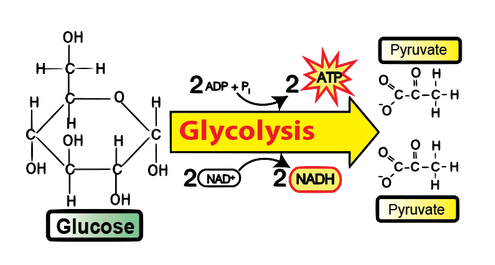
- Start with glucose
- End with pyruvate
- Produces 2 ATP and 2 NADH
What is the process of Embden-Meyerhoff Pathway (glycolysis)?
Breakdown of glucose to pyruvate (with oxygen, aerobic glycolysis) or lactate (without oxygen, anaerobic glycolysis)
What is the process of the Krebs Cycle (TCA or Citric Acid Cycle) ?
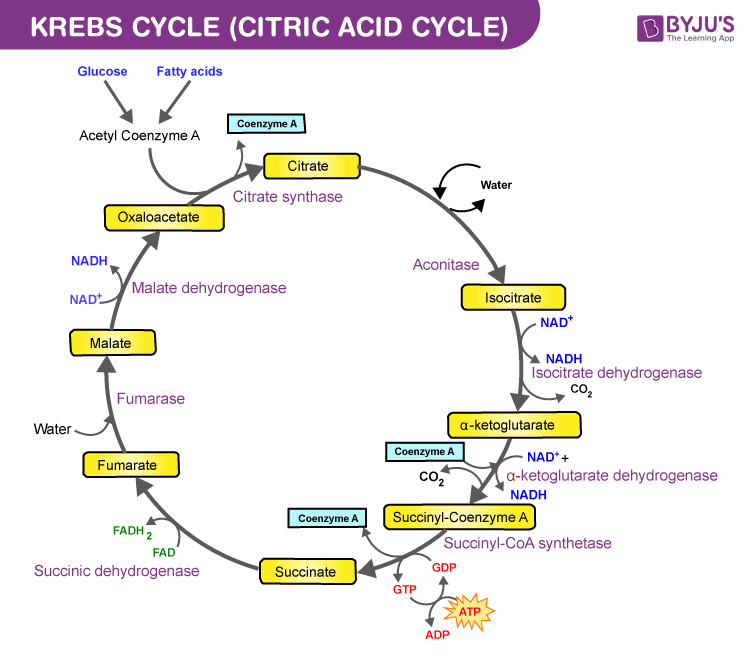
Turns acetyl Co-A into ATP for energy, and gives off electrons and H+
What is the process of the Hexose monophosphate (HMP) shunt or pentose phosphate pathway?
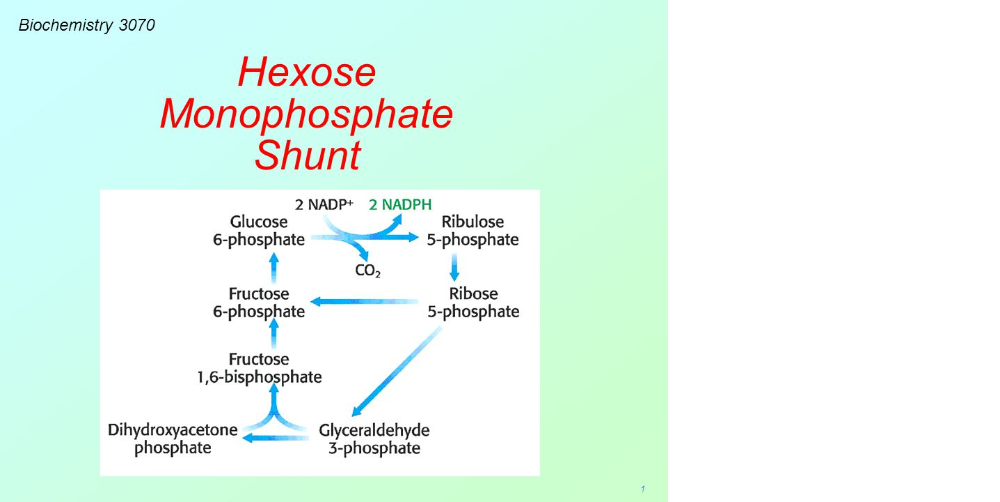
Oxidation of glucose to ribose + CO 2 + NADPH. Ribose for RNA and DNA
What is the definition of Glycogenesis?
- Formation of glycogen for energy storage
What is the definition of Glycogenolysis?
- Destruction of glycogen for energy usage
What is the definition of Gluconeogenesis ?
Formation of glucose from non-carbohydrate sources
What is the definition of Glycolysis?
- Destruction of glucose into pyruvate or lactate
What does Insulin do?
- ↑ glycolysis, glycogenesis, and lipogenesis. Released from the pancreatic
What does Glucagon do?
↑ glycogenolysis, gluconeogenesis, lipolysis
Released from the pancreatic
What does Somatostatin do?
Inhibits secretion of glucagon and insulin
Released from the Pancreatic ẟ cells, islets of Langerhans Note: statin for stable.
What do most other hormones that affect glucose do in carbohydrate regulation?
↑ glycogenolysis, gluconeogenesis
(Thyroxine, Growth Hormone, ACTH, Glucocorticoids, Epinephrine)
What hormone is principally charged with decreasing blood sugar?
Insulin
What are the 3 P's of diabetes?
- Polyuria: pee a lot
- Polydipsia drink: a lot,
- Polyphagia eat: a lot
What are the ADA(Americans with Disabilities Act ) Diagnostic Criteria values ?
Fasting Blood Sugar >126 mg/dL
Random Blood Sugar >200 mg/dL
2 hour Oral Glucose Tolerance Test "OGTT " >200 mg/dL
HbA1c >6.5%
What is the collateral damage for diabetes?
Renal damage - assess microalbumin (more sensitive in assessing glomerular function than Creatinine)
Cardiac damage - assess EKG (best screening test for stress on the heart)
Retinal damage - yearly ophthalmologist exam (best screening for diabetic retinopathy)
Diabetic foot ulcers - weekly/daily self check and prevention by avoiding injuries
!!What are the ADA(Americans with Disabilities Act ) Diagnostic Criteria values for gestational Diabetes?!!
Fasting blood sugar >92 mg/dL
1 hour Oral Glucose Tolerance Test (OGTT) >180 mg/dL
2 hour OGTT >153 mg/dL
Diagnosis is more strict for pregnant women than the nonpregnant population, why?
Elevated blood sugar increases the rate of Intrauterine Fetal Demise (IUFD)
Don’t want to birth a dead baby.
!!What are the ADA(Americans with Disabilities Act ) Diagnostic Criteria values for Hypoglycemia? !!
< 60 mg/dL in adults
< 45 mg/dL in infants,
What is Whipple’s Triad?
1.Documentation of hypoglycemia when symptomatic
2.Signs and Symptoms of hypoglycemia
3.Alleviation of symptoms after ingestion of glucose
What are the Adrenergic Symptoms?

1.Sweating
2.Shaking
3.Nervousness
4.“Feeling of impending doom”
What is the cause of postprandial hypoglycemia?
Hypersecretion of insulin following the ingestion of food
! What are the Important Values for Fasting Blood Glucose?!
!Reference Range for Glucose = 70-100 mg/dL!
Critical Serum or Plasma Glucose (All ages)
Below 40 mg/dL Brain Damage
Above 450 mg/dL Diabetic Coma
Critical Plasma Glucose (Newborn to 6 Wks)
Below 30 mg/dL Brain Damage
Above 300 mg/dL Diabetic Coma
What is are the signs and symptoms of Galactosemia?
Cause of ‘failure to thrive’ in infants
May lead to irreversible mental retardation, cataracts, and eventually blindness
Lab findings: 1. hypoglycemia 2. hyperbilirubinemia 3. accumulation of glycogen
What is the cause of hypoglycemia?
caused by inability to turn glycogen into glucose
What is Type I - G6PD Deficiency (von Gierke Disease)?
Most common enzyme deficiency worldwide. Most people are asymptomatic.
Enzyme deficiency for the last step in glycogenolysis, Glycogenolysis cannot occur
Episodes of intravascular hemolysis can occur after Plasmodium vivax infection, ingestion of medications that induce oxidative stress (Rifampin, methylene blue, Primaquin, Rasburicase, Sulfa drugs, etc.), fava beans, infections, or ketoacidosis
What is the chemical reaction for Glucose oxidase / Peroxidase - GOD / POD
Trinder reaction?
Glucose + O2 + H2O → Gluconic acid + 2 H2O2
H2O2 oxidizes many substrates catalyzed by Horseradish Peroxidase
H2O2 + reduced chromogen → Oxidized chromogen + H2O
What should you know about Hexokinase?
Catalyzes G-6-P formation in the presence of Mg ++
What is the oxidizing substance that is produced in the Trinder Reaction?
H2O2, Hydrogen Peroxide
!! What are the values need to know for Hemoglobin A1c?
Normal range is between 4.8-5.9%
Diabetes is diagnosed with a HbA1c >6.5%
note:Glucose binds non-enzymatically to all proteins
What to know about Glycated Albumin / Fructosamine?
HbA1c works just fine, until it doesn’t.
This can be caused by early red cell destruction like hemolysis, or more commonly dialysis.
A physician is wondering what the long-term glucose control has been in one of her patients. What test(s) should she order?
HbA1c initially, because it looks at the glycosylated hemoglobin molecules still in the blood. Since red cells turn over every 90 days or so, this test is only good to look at the last 90 days of control. If the patient has high red-cell turnover (sickle cell anemia, hemolysis, bleeding, etc.), then the test will not look at the last 90 days, and a fructosamine or glycated albumin test should be ordered.
What is an important Ketone to know?
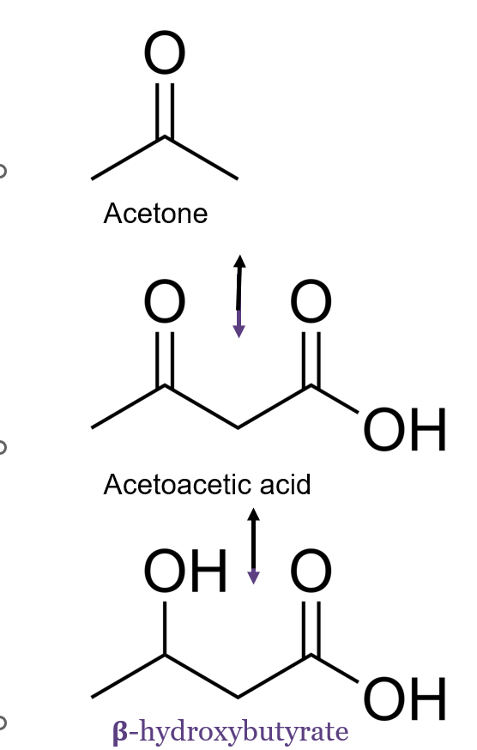
What to know about the lactate process.
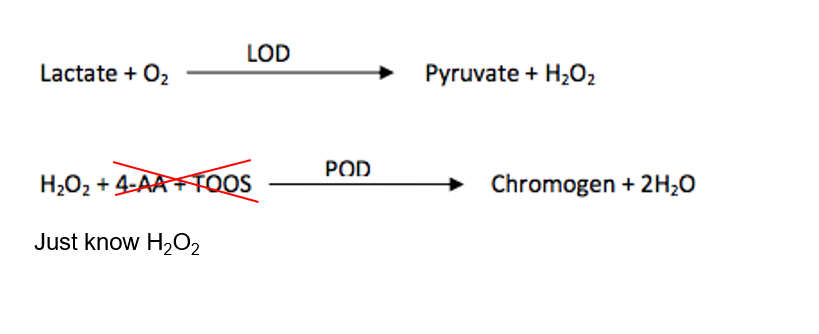
Lactate is produced in glycolysis when oxygen is NOT present (e.g. exercise, heart attack, etc.)
Interferences:
- Bilirubin over 274 umol/L
- Hemolysis over 5.0 g/L
- Lipemia over 11.3 mmol/L
- Ascorbate over 568 umol/L
Know that the chromogen creates a color change
What is Glycorrhachia ?
the presence of glucose in the CSF and is a NORMAL finding
!CSF glucose should be ⅔ the plasma glucose!
For urine glucose what is the renal threshold?
!The Renal Threshold for glucose is 180 mg/dL!
What ketone is measured in our analyzers?
Acetoacetic acid
When testing for insulin what do the these parameters indicate:
High Insulin and Low Glucose =
Hyperinsulinemia, either an insulin-secreting tumor or exogenous insulin administration
When testing for insulin what do the these parameters indicate:
High Insulin and High Glucose =
Insulin insensitivity
When testing for insulin what do the these parameters indicate:
Low Insulin and High Glucose =
Type I Diabetes
When testing for insulin what do the these parameters indicate:
Low Insulin and Low Glucose =
Starvation, ↑ Glucagon
What is important to know about the C-Peptide ratio?
C-Peptide and Insulin are created in a 1:1 ratio
If a patient lakes C-peptide, but has lots of insulin in comes
from an injection. Could mean murder or Munchausen syndrome a mental
condition in which a person repeatedly seeks medical attention for
falsified, exaggerated, or self-inflicted physical symptoms.
What are the reference values for glucose in a separated vs non separated vile of blood?
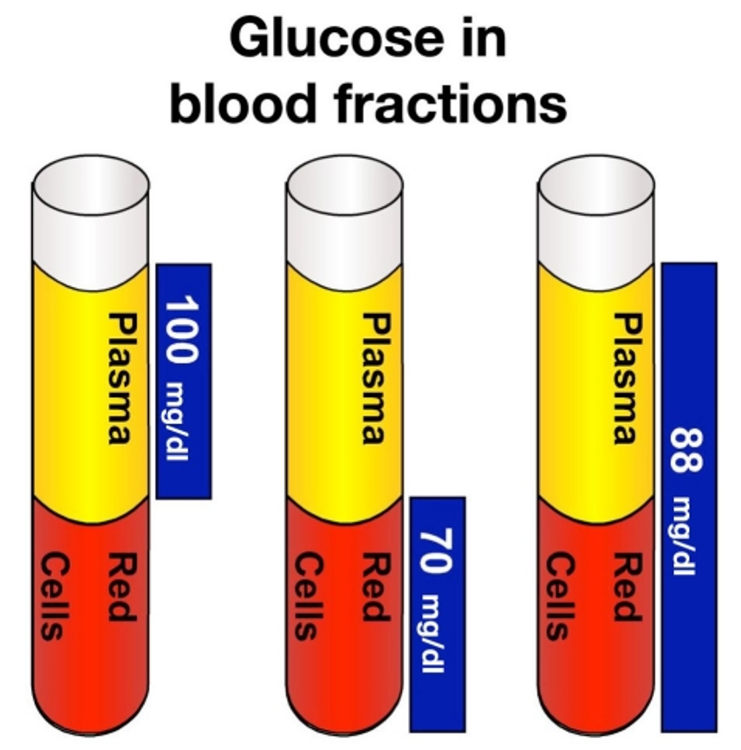
These are just example know the principle not the exact numbers.
- Plasma 100 mg/dl
- Red cells 70 mg/dl
- whole blood 88 mg/dl Note: this is the average of plasma and red cells
A female athlete is exercising to her max and using all of her
energy. What
glycolytic pathway is likely being used?
Answer: Anaerobic glycolysis is likely being used in this situation.
Anaerobic
glycolysis is the body’s last ditch effort to try and
create some ATP. It is not
efficient at all and only creates 2
ATP, whereas, with the use of the electron
transport chain and
the presence of oxygen as the terminal electron acceptor,
38 ATP
can be created from each molecule of glucose. That’s a much better
investment!
What ketone is measured by our machines?
Acetoacetic acid
What hormone is principally in charge of decreasing blood sugar?
Insulin
What is the action and source for the following hormone: Thyroxine?
Action:↑ gluconeogenesis ↑ glycogenolysis
Source:Thyroid gland
What is the action and source for the following hormone: Somatostatin?
Action: Inhibits secretion of insulin and glucagon
Source: ẟ cells in the pancreas
What is the action and source for the following hormone: Adrenocorticotropic Hormone (ACTH)?
Action: ↑ gluconeogenesis ↑ glycogenolysis ↑ lipolysis
Source: Anterior pituitary gland
What is the action and source for the following hormone: Growth Hormone (GH)?
Action: ↑ gluconeogenesis ↑ glycogenolysis ↑ lipolysis
Source: Anterior pituitary gland
What is the action and source for the following hormone:Epinephrine?
Action: ↑ gluconeogenesis ↑ glycogenolysis ↑ lipolysis
Source: Adrenal medulla
What is the action and source for the following hormone:Glucocorticoids (Cortisol)?
Action: ↑ gluconeogenesis ↑ glycogenolysis ↑ lipolysis
Source: Adrenal cortex
What method is recommended to analyze glucose if the patient is on dialysis?
Hexokinase
What is the standard tube to be drawn if you want to make sure that
glycolysis is
halted for a long time?
Na fluoride (gray top)
A 37-year-old male and well-controlled long term type 1 diabetic,
presents to his physician complaining of vague abdominal pain. He is
also being treated for agammaglobulinemia with intravenous
immunoglobulins (IVIG). His glucose values at his last checkup were
high (155 mg/dL) on the laboratory test, but his home glucose monitor
tells him that his glucose values are usually between 95-120 mg/dL.
What is the most likely reason for this testing discrepancy?
A.
The laboratory is in a better controlled environment
B. The
method is not the same
C. The patient is on dialysis
D. The
sample is not the same
Answer:
The correct answer is D) The sample is not the same.
This question has a couple of
steps to it, so let’s start at the
surface then go to the underlying problem. The patient is complaining
of nonspecific symptoms, so we can’t tell what’s going on clinically.
We also know that he is comparing laboratory results, which are spun
down, so the sample is usually plasma. The sample for at home blood
monitoring is whole blood. Most people don’t have a centrifuge for at
home use.
(Answer A) The laboratory is in a better controlled environment is a true statement, but doesn’t likely apply in this case. We also know that he is being treated with IVIG, which contains maltose. Maltose cross-reacts in the glucose oxidase method and falsely-elevates the glucose value (Answer C). Maltose does NOT do this with the hexokinase method. This would be a problem (Answer B) IF we were comparing these two test methods.
A 57-year-old female with Cushing syndrome is having a difficult time
controlling her blood glucose levels. She has tried diet, exercise,
and even prolonged fasting. Nothing has worked. What is the likely
hormone causing this issue?
A. ACTH
B. Cortisol
C.
Epinephrine
D. Growth Hormone
Answer:
The correct answer is B). Cushing syndrome is defined by
an increase in Cortisol which increases glucose levels in the blood.
This makes it incredibly difficult to control blood sugar. ACTH is not
correct because it refers to Cushing disease, which is specifically
defined as an ACTH-secreting pituitary tumor. Cushing syndrome is the
umbrella term for increased cortisol, but it doesn’t tell us exactly
the mechanism behind it.
A 7-year-old female is complaining of abdominal pain. She has
urinated 17 times today and has eaten 12 bowls of Kellogg’s® Frosted
Flakes. Her mother takes her into her pediatrician who quickly makes a
diagnosis of new-onset Type 1 Diabetes with a glucose value of 817
mg/dL! If this patient is in ketoacidosis, then what will likely be
the most prevalent ketone?
A. Acetoacetate
B.
Acetone
C.
Answer:
The correct answer is C)
A physician is wondering what the long-term control of his patient’s glucose has been. What test should she order?
Answer:
HbA1c because it looks at the glycosylated hemoglobin
molecules still in the blood. Since red cells turn over every 90 days
or so, this test is only good to look at the last 90 days of control.
What is the cause of postprandial hypoglycemia?
Hypersecretion of insulin following the ingestion of food
Name a deadly long-term complications of diabetes
Myocardial Infarction, stroke, or renal failure
What is the diagnostic value of Diabetes for a patient who just ate
a
cheeseburger, fries, and a shake at McDonalds?
Answer:
200 mg/dL
A 59-year-old male patient comes in for a physical examination. He
has not been to the physician in 15 years because he says, “I can take
care of myself.” The reason why he came in is because he can’t feel
his feet anymore and has this festering wound over his calcaneus. He
thought that he just needed some antibiotics, so he decided that he
needed to go to the physician to get those. He is diagnosed with Type
2 diabetes and he wants to treat it and go home. He is given insulin,
but he doesn’t take it. What is the most likely fatal side effect of
his long-standing diabetes?
A. Gastroparesis
B. Lactic
acidosis
C. Myocardial infarction
D. Nonhealing ulcer
Answer:
The correct answer is C) Myocardial infarction. This is
one of the most dangerous long-term side effects of diabetes along
with strokes and renal failure. We diagnose thisby evaluating troponin
I (TnI). This becomes elevated to detectable levels in just 2-3 hours,
whereas, the other specific marker for myocardial damage, CK-MB, does
not elevate for 6-10 hours. This is why TnI is the best test. However,
laboratories continue to offer CK-MB. There has been a push to replace
CK-MB with Troponins.
A 12-year-old girl has been feeling dizzy and sweaty. She is found to
have tachycardia and is very anxious and she comes from an anxious
family. She says that she feels this way each day about an hour after
she eats, but it usually resolves after she eats a box of runts. What
is her likely condition?
A. Gestational Diabetes
B.
Postprandial Hypoglycemia
C. Type 1 Diabetes
D. Type 2 Diabetes
Answer:
The correct answer is B) Postprandial Hypoglycemia.
Recognize Whipple’s triad in this case presentation and these symptoms
appear after meals. The only thing that we’re missing is documented
hypoglycemia while the patient is symptomatic
3. A 38-year-old long-term insulin-dependent diabetic male is having
problems with his eyesight. He says that he’s starting to go blind.
His physician reminds him that Diabetic Retinopathy is a feared
complication of uncontrolled long-term diabetes and asks his patient
if he has been taking his insulin. The patient replied with a “yes”.
What laboratory test would help to assess the sensitivity of insulin
in the peripheral tissues?
A. 2 Hour OGTT
B. Fasting Serum
Glucose
C. HbA1c
D. Random Serum Glucose
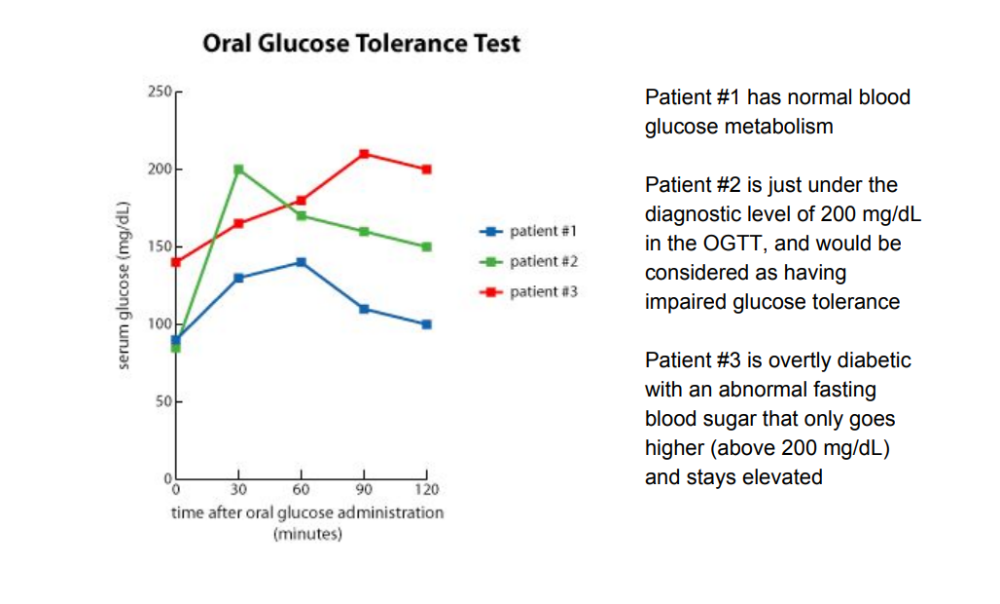
The correct answer is A) 2 Hour OGTT. The 2 hour OGTT is a test in which a standard glucose load is given to the patient. We are interested in seeing how the patient decreases this glucose over the next 2 hours. This is demonstrated in the figure below: